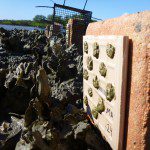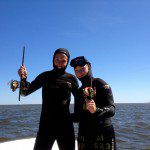Predator fear, biodiversity, and the collapse of the Apalachicola oyster fishery. The second In the Grass, On the Reef documentary follows four years of research into the ecology of the coast.
Oyster Doctors examines the value of scientific research. Does it matter if predators scare mud crabs into not eating oysters? Does this science only have value when the techniques developed are used to help restore an economically important resource? Set against the backdrop of Florida’s spectacular Forgotten Coast, our researcher’s failures and triumphs lead to unexpected discoveries and an ever-expanding string of questions about the inner workings of our coasts. You’ll never look at your seafood the same way again.
 In their biogeographic oyster study, Dr. David Kimbro, Dr. Randall Hughes, and their colleagues investigate predators and their control over the oyster reef ecosystem. Predators can eat the consumers of oysters and limit their numbers, but fear might have a stronger effect. And if it does, how does that effect vary across different geographic regions with different top predators?
In their biogeographic oyster study, Dr. David Kimbro, Dr. Randall Hughes, and their colleagues investigate predators and their control over the oyster reef ecosystem. Predators can eat the consumers of oysters and limit their numbers, but fear might have a stronger effect. And if it does, how does that effect vary across different geographic regions with different top predators?
 In his Apalachicola Bay study, David and his crew are investigating the collapse of the Apalachicola oyster fishery. What combinations of environmental factors (such as drought or increased salinity) and predator effects derailed Florida’s biggest oyster producer? Many of the tools and techniques used in this experiment were developed during the biogeographic study.
In his Apalachicola Bay study, David and his crew are investigating the collapse of the Apalachicola oyster fishery. What combinations of environmental factors (such as drought or increased salinity) and predator effects derailed Florida’s biggest oyster producer? Many of the tools and techniques used in this experiment were developed during the biogeographic study.
 Salt marshes are as productive a habitat as oyster reefs, and just as vulnerable to drought. In her biodiversity study, Randall looks at how the genetic makeup of a salt marsh may make it less susceptible to disturbances.
Salt marshes are as productive a habitat as oyster reefs, and just as vulnerable to drought. In her biodiversity study, Randall looks at how the genetic makeup of a salt marsh may make it less susceptible to disturbances.
 For a few days each month, the tide might get low enough at Bay Mouth Bar to expose its seagrass beds and the incredible diversity of life they shelter. David and his lab have repeated surveys conducted in the late 1950s by Dr. Robert Paine and found a few significant changes have occurred over the last fifty years. Like oyster reefs, the removal of a top predatory species could play a role in these changes to the sandbar.
For a few days each month, the tide might get low enough at Bay Mouth Bar to expose its seagrass beds and the incredible diversity of life they shelter. David and his lab have repeated surveys conducted in the late 1950s by Dr. Robert Paine and found a few significant changes have occurred over the last fifty years. Like oyster reefs, the removal of a top predatory species could play a role in these changes to the sandbar.

